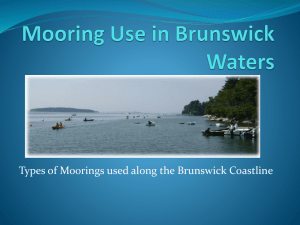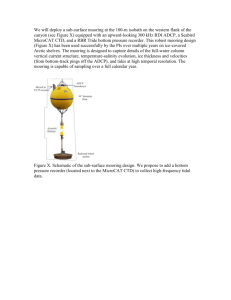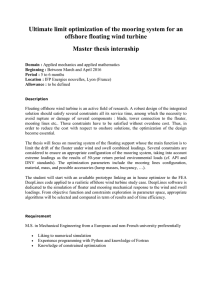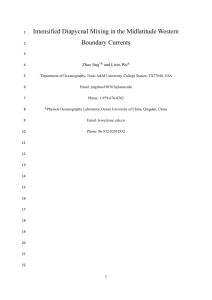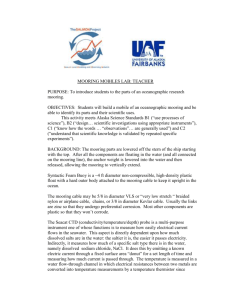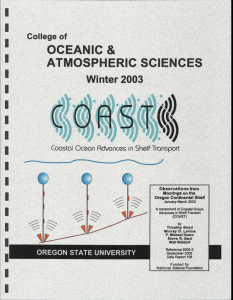COAST 2001 MOORINGS 40 HOUR LOW-PASS FILTERED VELOCITY COMPONENTS
advertisement
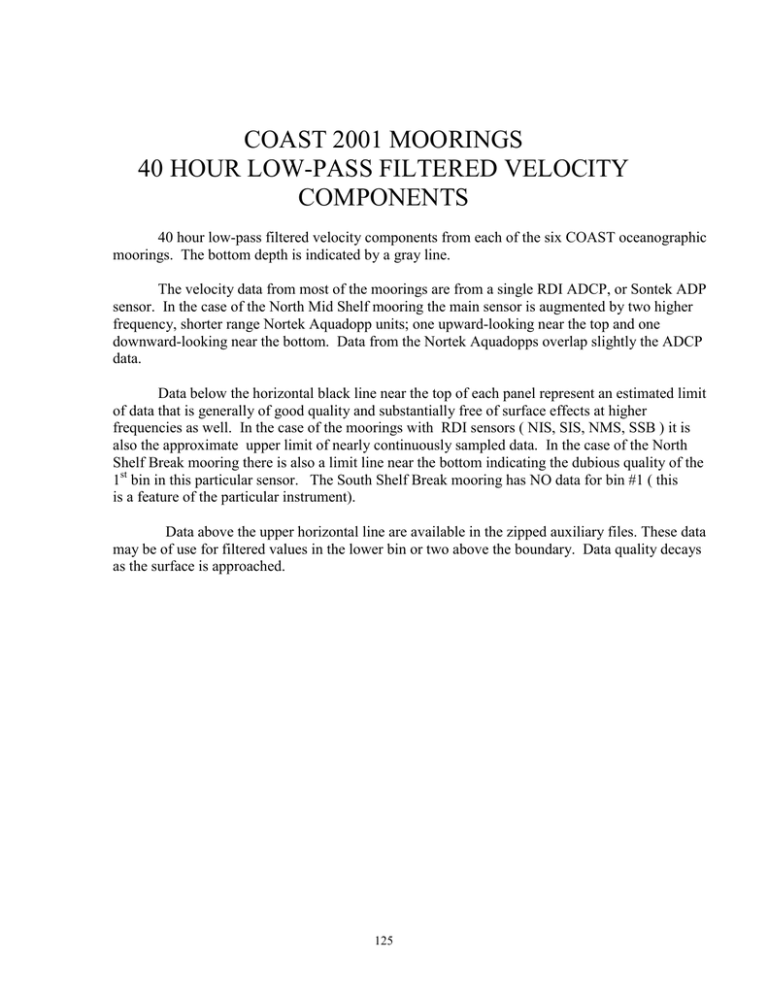
COAST 2001 MOORINGS 40 HOUR LOW-PASS FILTERED VELOCITY COMPONENTS 40 hour low-pass filtered velocity components from each of the six COAST oceanographic moorings. The bottom depth is indicated by a gray line. The velocity data from most of the moorings are from a single RDI ADCP, or Sontek ADP sensor. In the case of the North Mid Shelf mooring the main sensor is augmented by two higher frequency, shorter range Nortek Aquadopp units; one upward-looking near the top and one downward-looking near the bottom. Data from the Nortek Aquadopps overlap slightly the ADCP data. Data below the horizontal black line near the top of each panel represent an estimated limit of data that is generally of good quality and substantially free of surface effects at higher frequencies as well. In the case of the moorings with RDI sensors ( NIS, SIS, NMS, SSB ) it is also the approximate upper limit of nearly continuously sampled data. In the case of the North Shelf Break mooring there is also a limit line near the bottom indicating the dubious quality of the 1st bin in this particular sensor. The South Shelf Break mooring has NO data for bin #1 ( this is a feature of the particular instrument). Data above the upper horizontal line are available in the zipped auxiliary files. These data may be of use for filtered values in the lower bin or two above the boundary. Data quality decays as the surface is approached. 125 136 COAST 2001 MOORINGS 1 HOUR LOW-PASS FILTERED VELOCITY COMPONENTS Acoustic Doppler velocities for each of the 6 main moorings are shown at 18 days/panel for every other depth bin up to the estimated limits of data that are substantially free of surface interference. Also shown for each mooring is an additional depth bin closer to the surface plotted in red. Depth of each bin is drawn on right hand edge of page. Velocities are shown offset relative to depth; a horizontal line is drawn at that depth representing 0 cm/sec. The velocity scale is shown in red at the upper left of each page; north and east are up. The North Mid Shelf mooring also had 2 ancillary short range Nortek doppler units which extend the vertical range of the velocity measurement. The Nortek data is plotted in similar fashion to the others in shades of brown/orange. For readability only a few of the closely spaced bins are shown. The figures shown are selected subsets of the data that do not illustrate some of the data quality issues discussed in the text or seen in higher resolution figures on the CD. Data compromised by reflections from mooring components are not shown here. Some data quality information is shown in these pages. The RDI ADCP returns a data value only if the data quality of the reflected signal in each of 4 beams exceeds a specified threshold. We use the percentage of such good pings per ensemble as a measure of data quality. A data point is used as input to the 1-hour filter only if more than 90% of the pings in the ensemble are good, and if this criterion is also met for more than 50% of the points in both the left and right halves of the filter window. Gaps in the velocity lines are failures of these conditions and have been set to IEEE NaN in the files on the data CD. The 3 beam Sontek sensors on the South Mid Shelf and North Shelf Break moorings always return a value regardless of conditions. There is no equivalent to the RDI % good pings. Velocity component statistics, signal/noise ratio, and signal amplitude are used in judging overall quality, but not on a point by point basis. The Sontek diagnostic of Standard Deviation Per Ensemble (SDPE) seems to provide a good measure of interference from biological sources (fish, squid, arthropods, etc.). For the SMS and NSB Sontek ADPs, intermittent magenta colored velocity sections indicate high values of filtered SDPE (> 6), and thus likely data quality loss. 137 174 COAST 2001 MOORINGS 40 HOUR LOW-PASS FILTERED SALINITY 40 hour low-pass filtered salinities from each of the six COAST oceanographic moorings are shown with each sensor identified by color. The depth of the sensors are shown on the right side of the each panel Two sets of plots are provided. The scale of the first set of plots covers the entire range of variability at each mooring. The second set of plots is scaled to illustrate the salinity variability of the deeper sensors on each mooring. 175 COAST 2001 MOORINGS METEOROLOGICAL DATA Unfiltered solar radiation, air pressure, relative humidity, wind vectors, air temperature, and water temperature from 1.5 m depth are shown on a single page. Meteorological data from the main met package on the Meteorological Mooring are at 15 minute sample rate. Daily averages are taken Pacific Time. Also shown are the partial records of humidity from the Northern Inner Shelf and Northern Shelf Break moorings at 10 minute sample rate. Air Temperature records are available for all of the mooring locations other than Southern Shelf Break (due to loss of instrument). Multiple air temperature sensors provide redundant records for each of the three northern mooring sites. Wind velocity vectors are shown in oceanographic convention of direction towards which the wind is blowing (up indicates wind blowing to the north). Relative Humidity is shown as recorded and is not clipped to 100% maximum. Abbreviations: MET = Meteorological Mooring NIS = Northern Inner Shelf Mooring NSB = Northern Shelf Break Mooring. 180 COAST 2001 MOORINGS WATER PRESSURE SENSORS Shown here are the demeaned pressure time series for all moorings. All are drawn at a common scale seen on the left side of the pages. The mean value in decibars for each time period is on the right. For the Northern midshelf mooring which has 4 sensors there are 2 panels, the upper one with the shallower sensors, and the lower with the 2 near 70m. The Nortek sensors are indicated by Magenta lines. Note that for these 2 panels the line thickness is varied to enhance the visibility of 2 sensors very nearly on top of each other. The data are every 4 minutes, subsampled where needed with the exception of the upper Nortek and the 70m Seabird/Paroscientific, which sampled at 8 minutes. The data have been left unedited for small spikes to give an indication of the general behavior of each sensor. The moorings are identified on each page by our usual abbreviations: NIS Northern Innershelf NMS Northern Midshelf NSB Northern Shelfbreak SIS Southern Innershelf SMS Southern Midshelf SSB Southern Shelfbreak Also shown is a 40-hour low-pass filtered plot with all of the relatively shallow pressure sensors in one panel, and the NMS near-70 m Paroscientific Digiquartz and Nortek 2MHz sensors in a separate panel. As many of the pressure time series are incomplete a variable width filter was used to provide more coverage in time. 188
